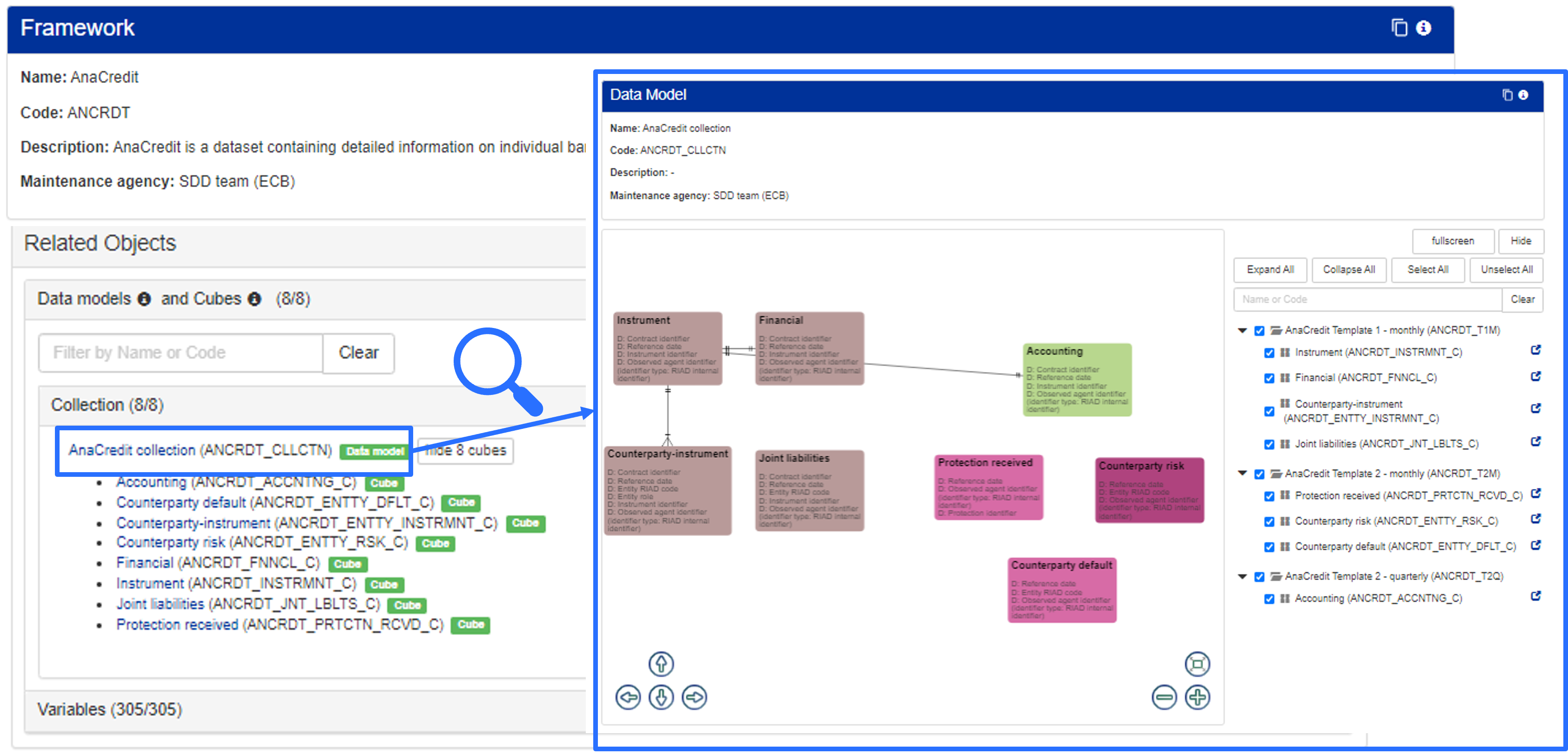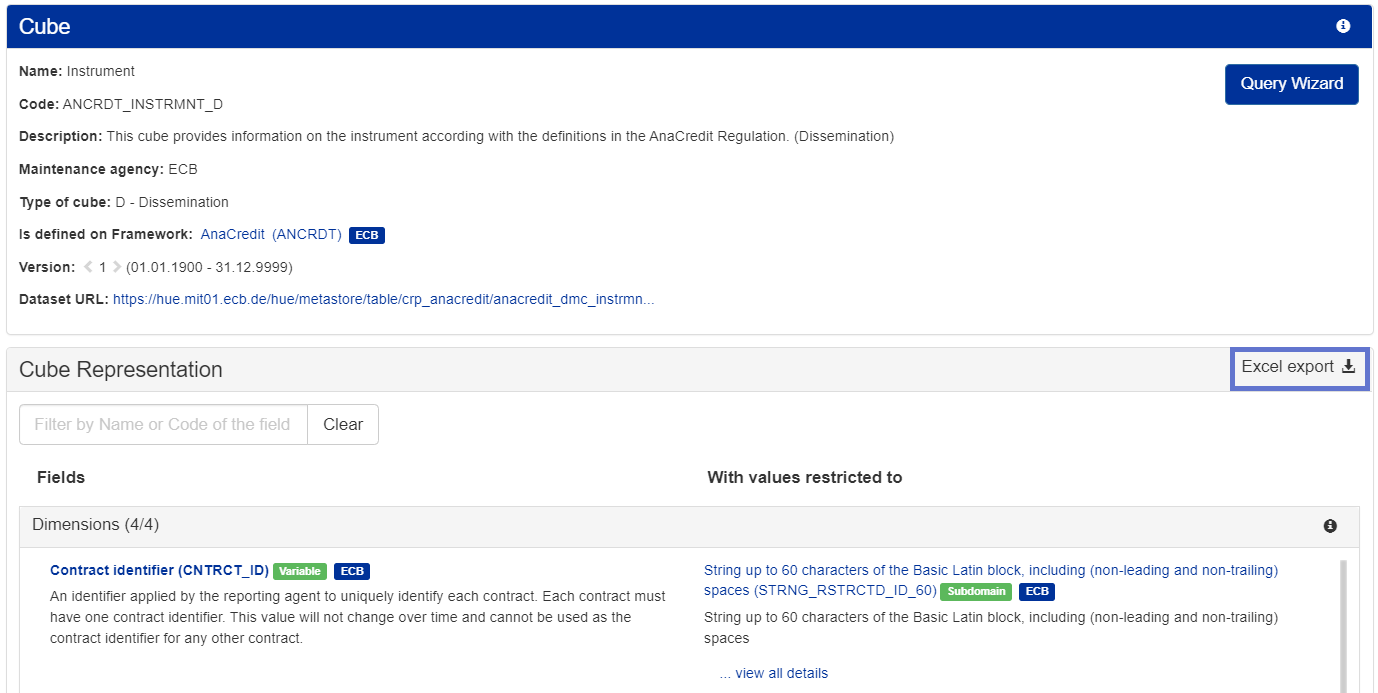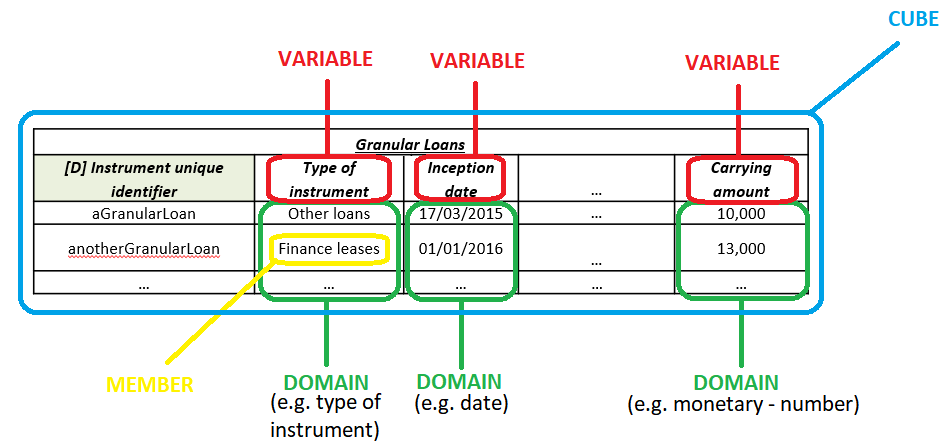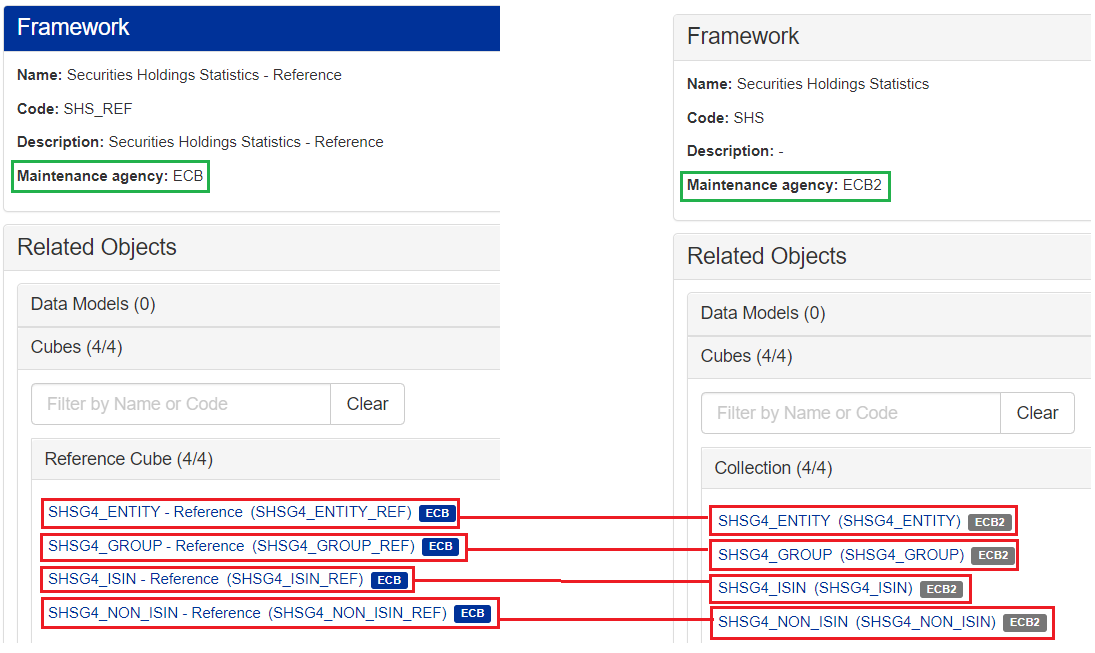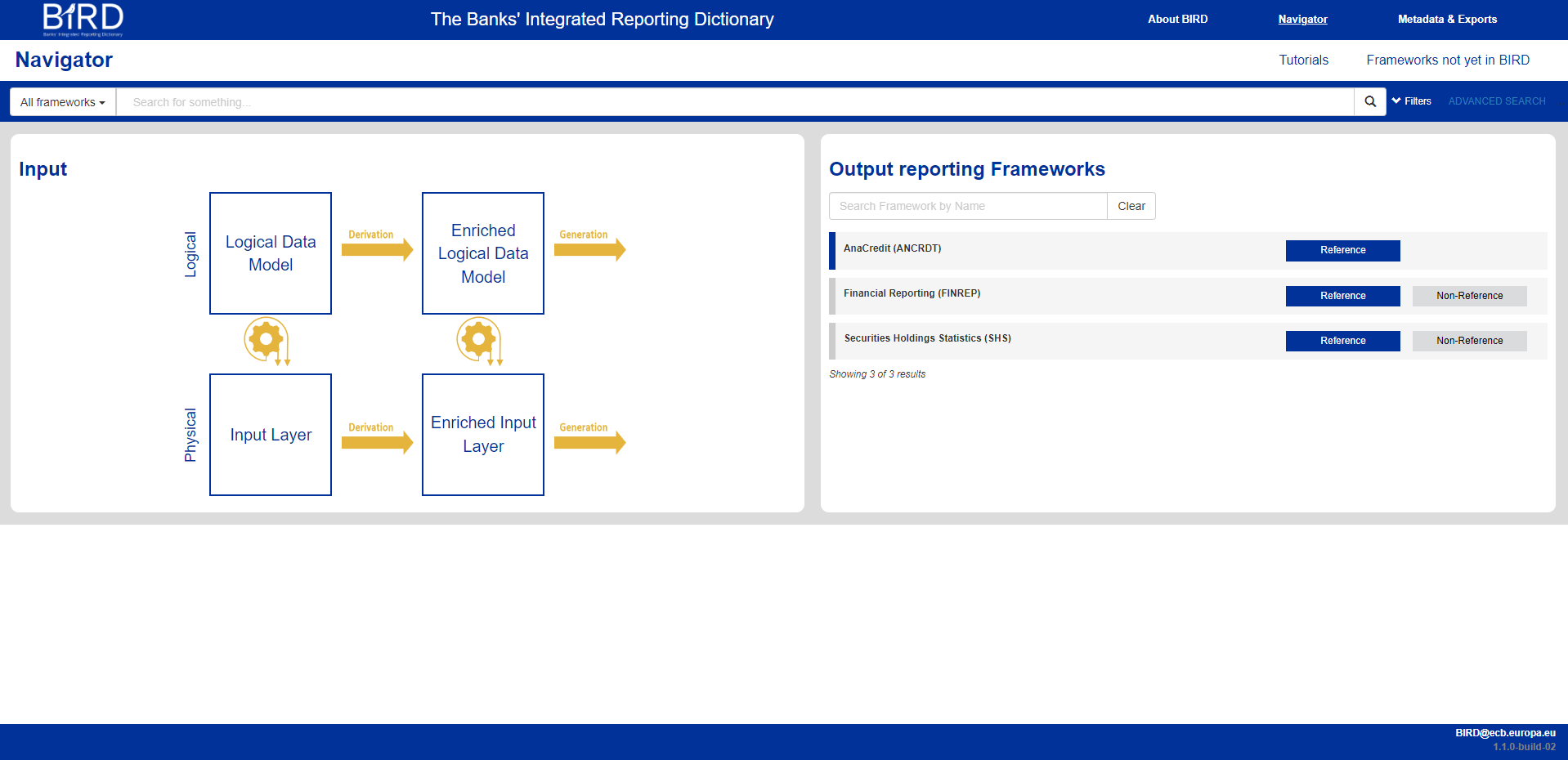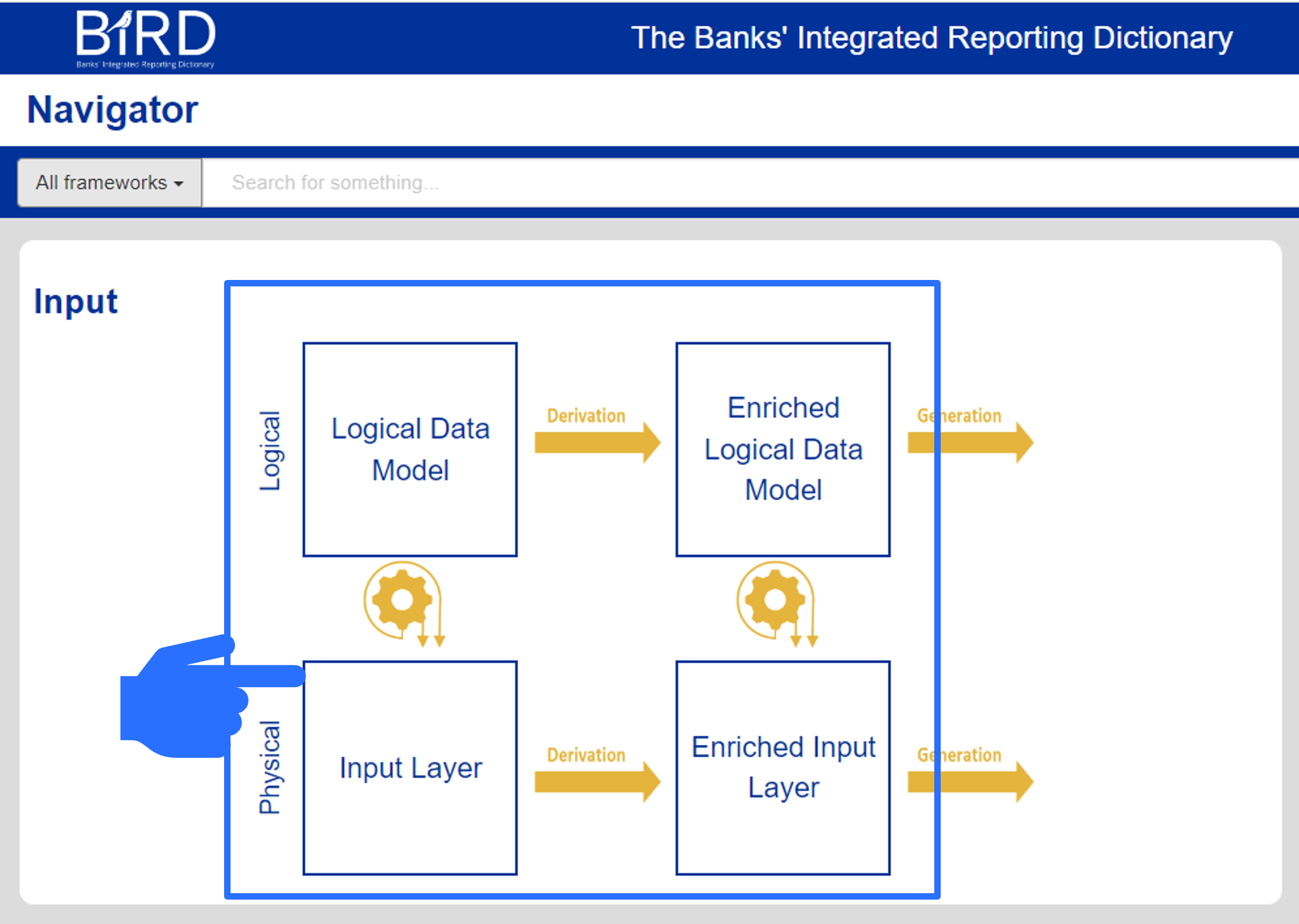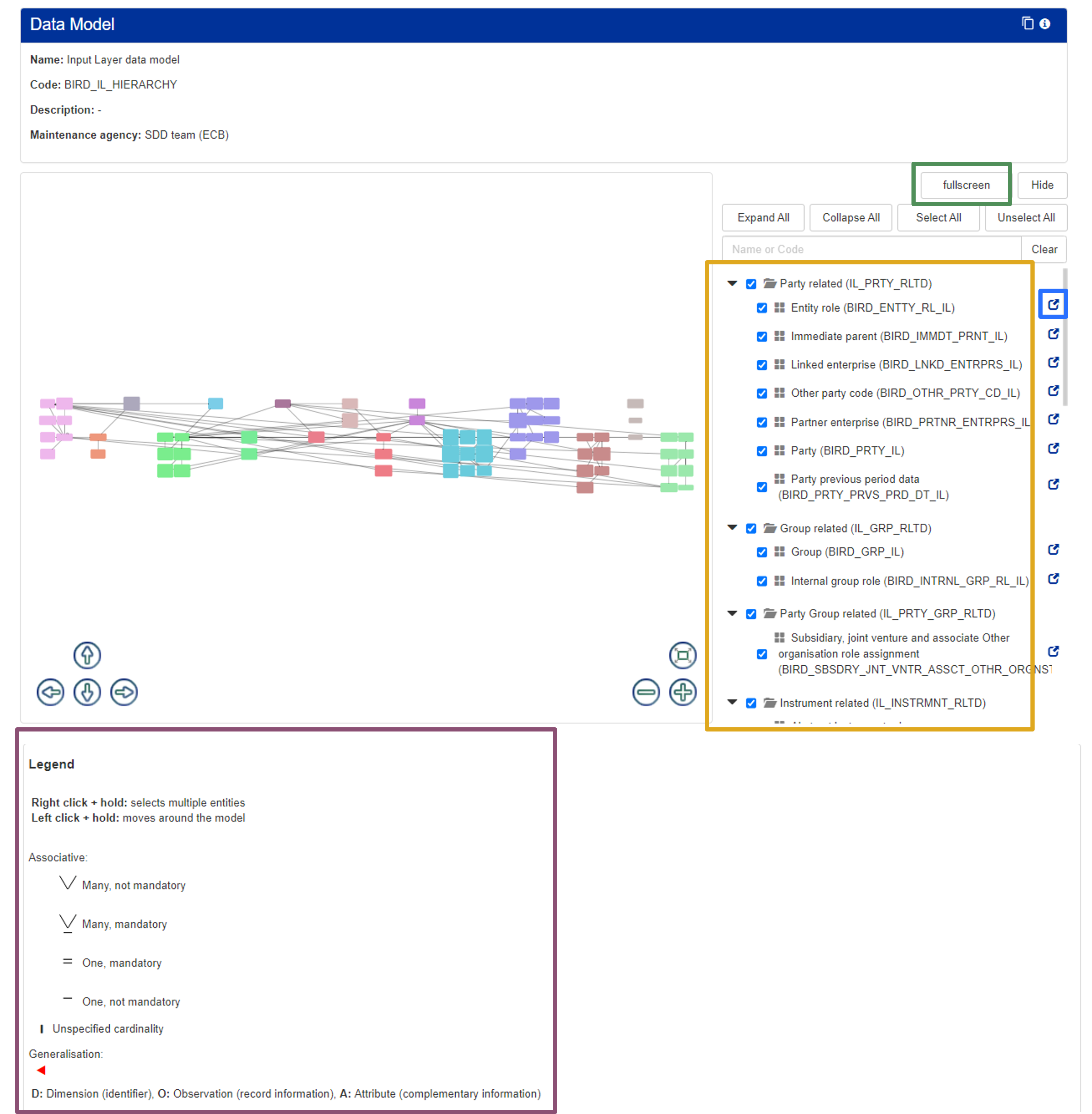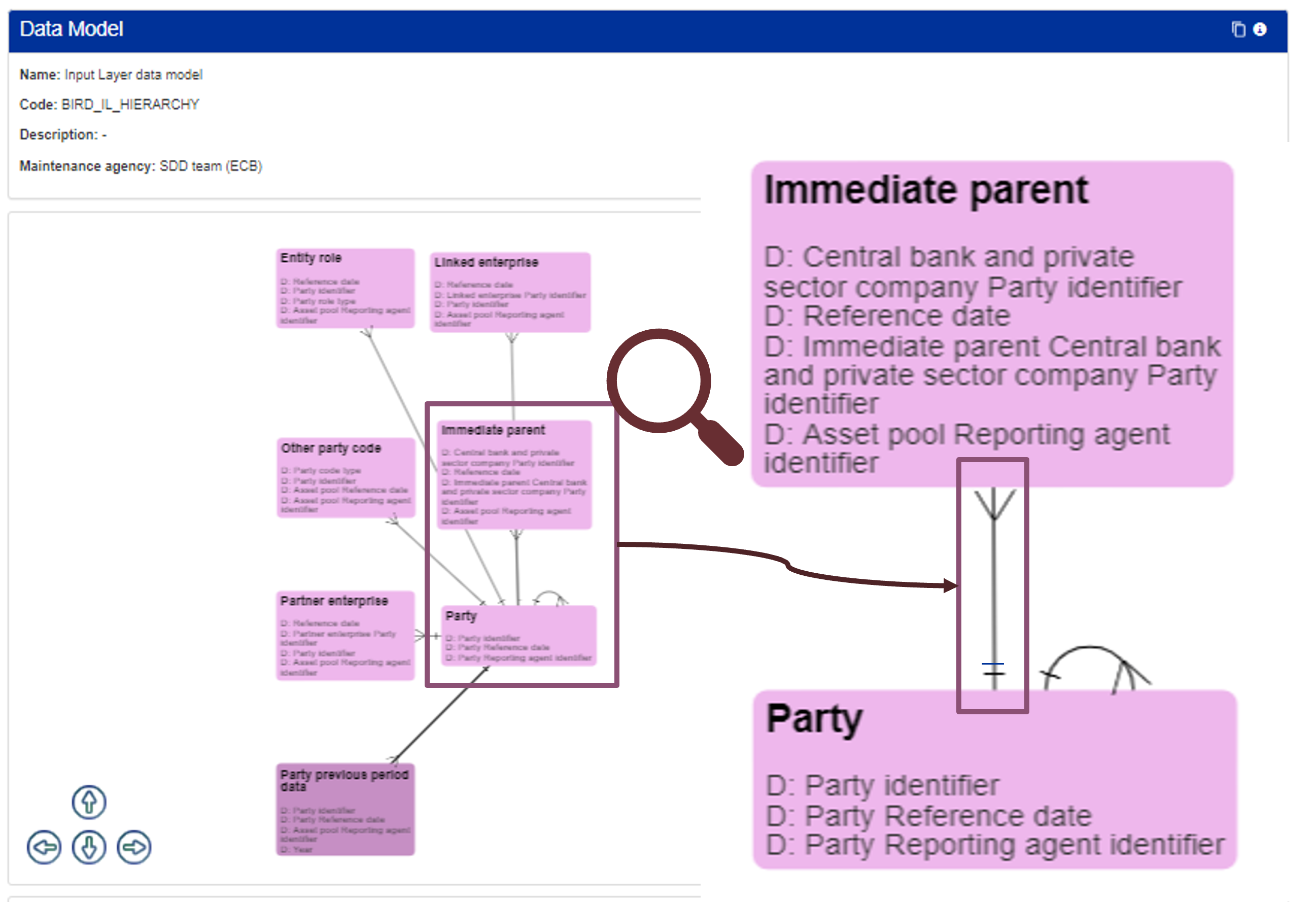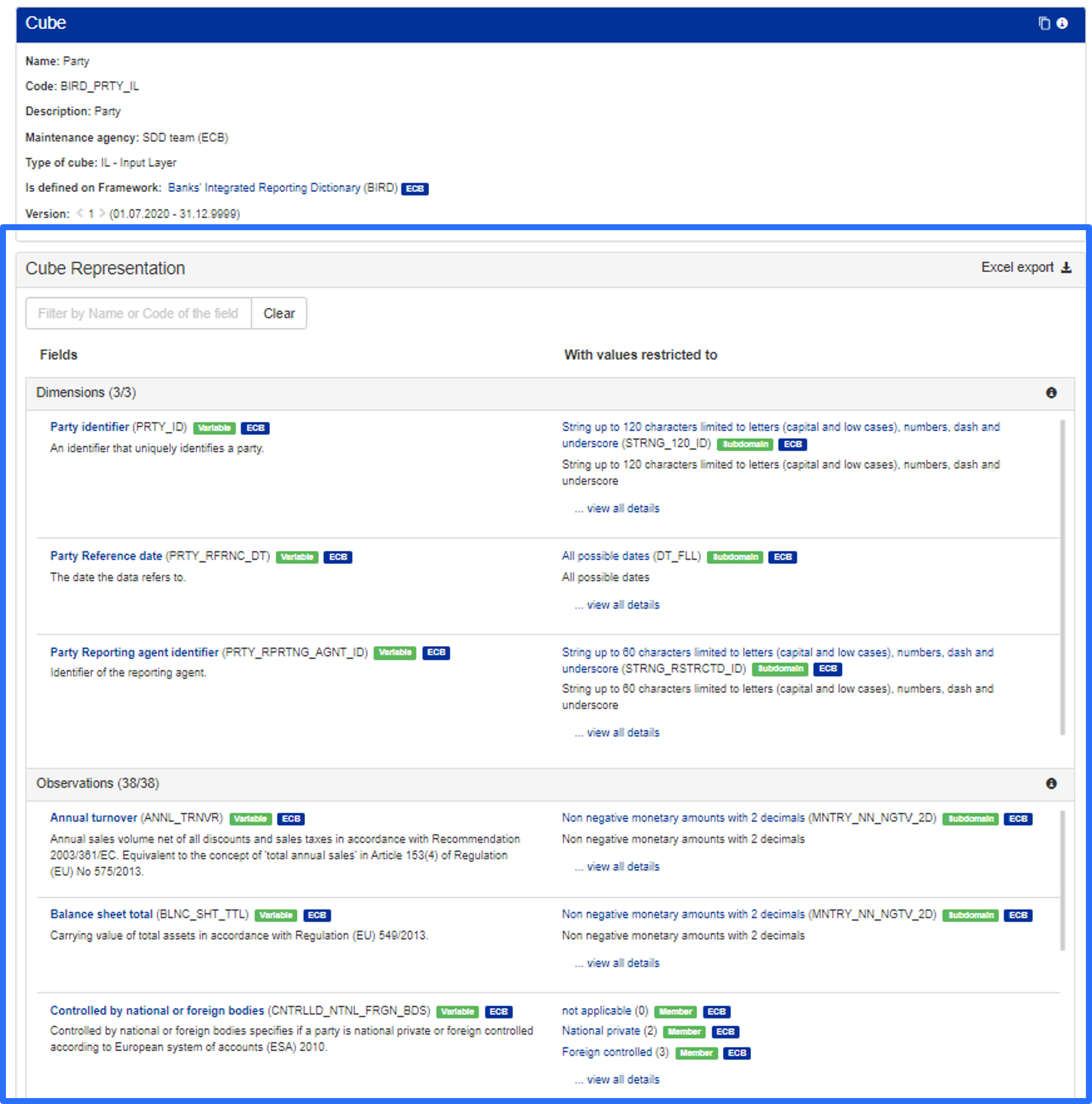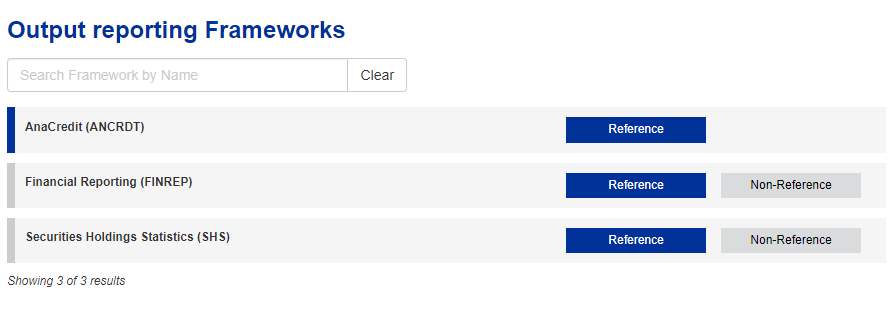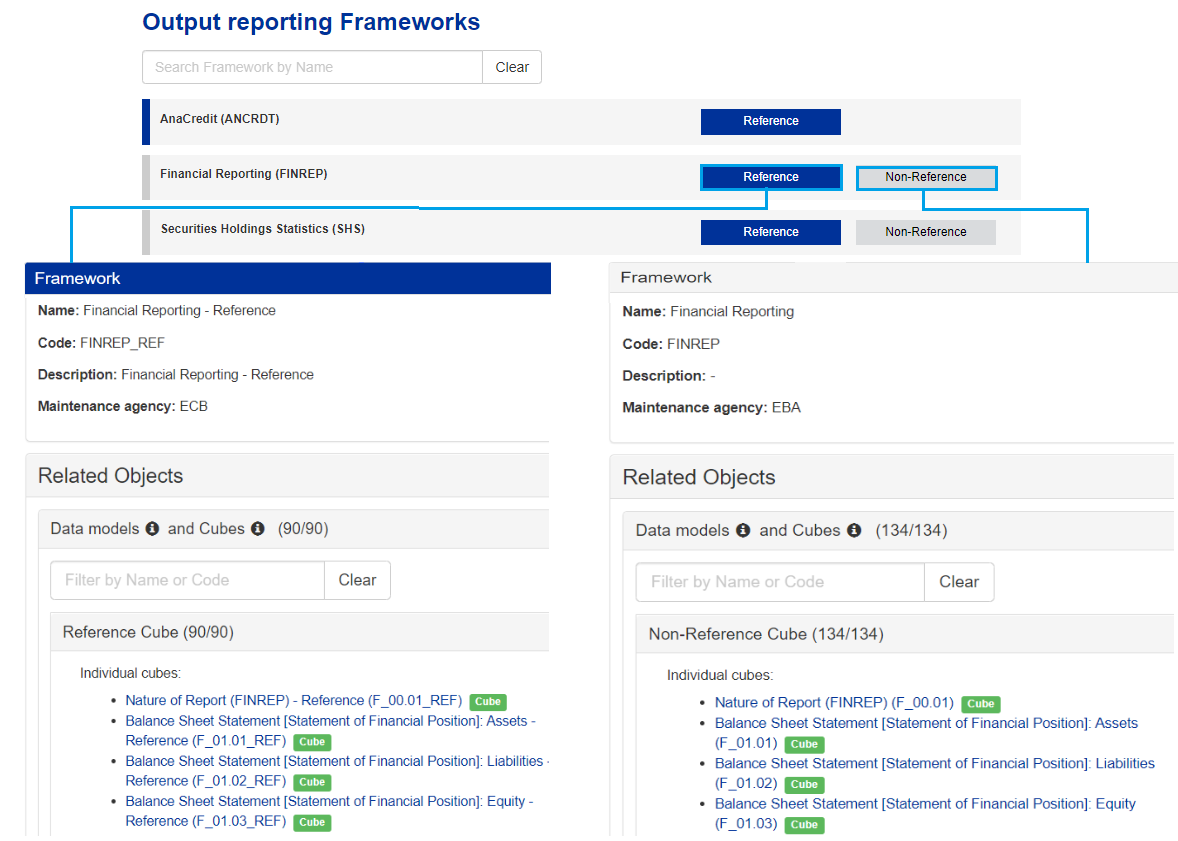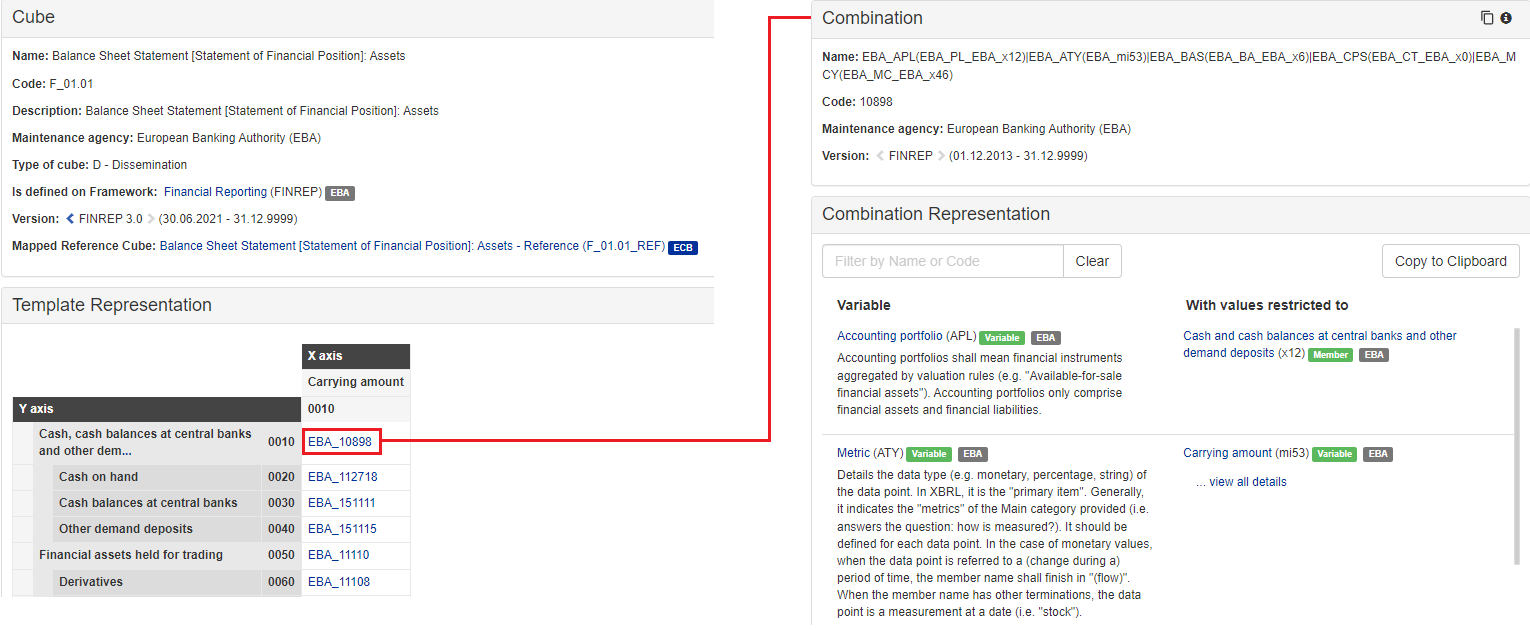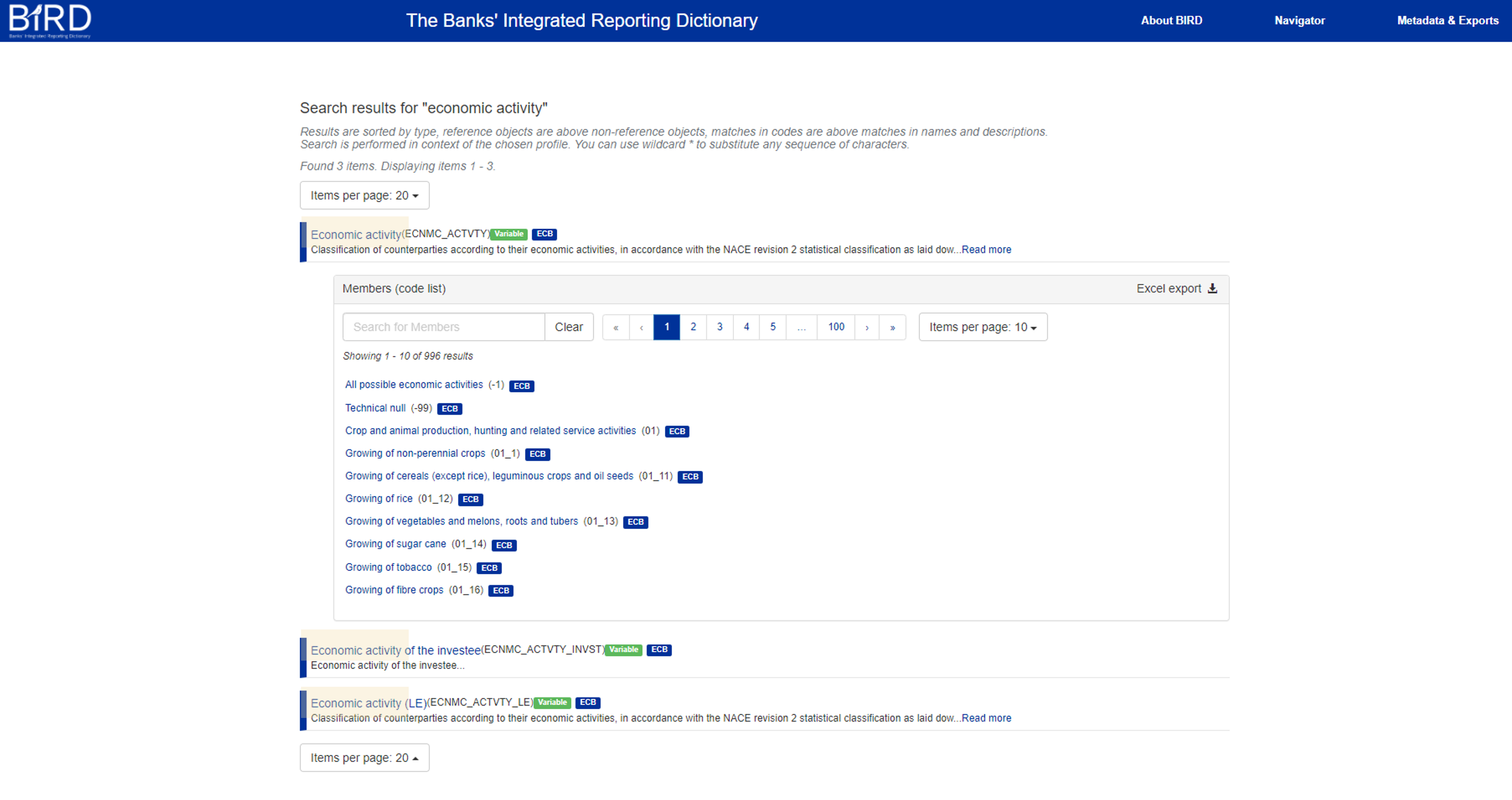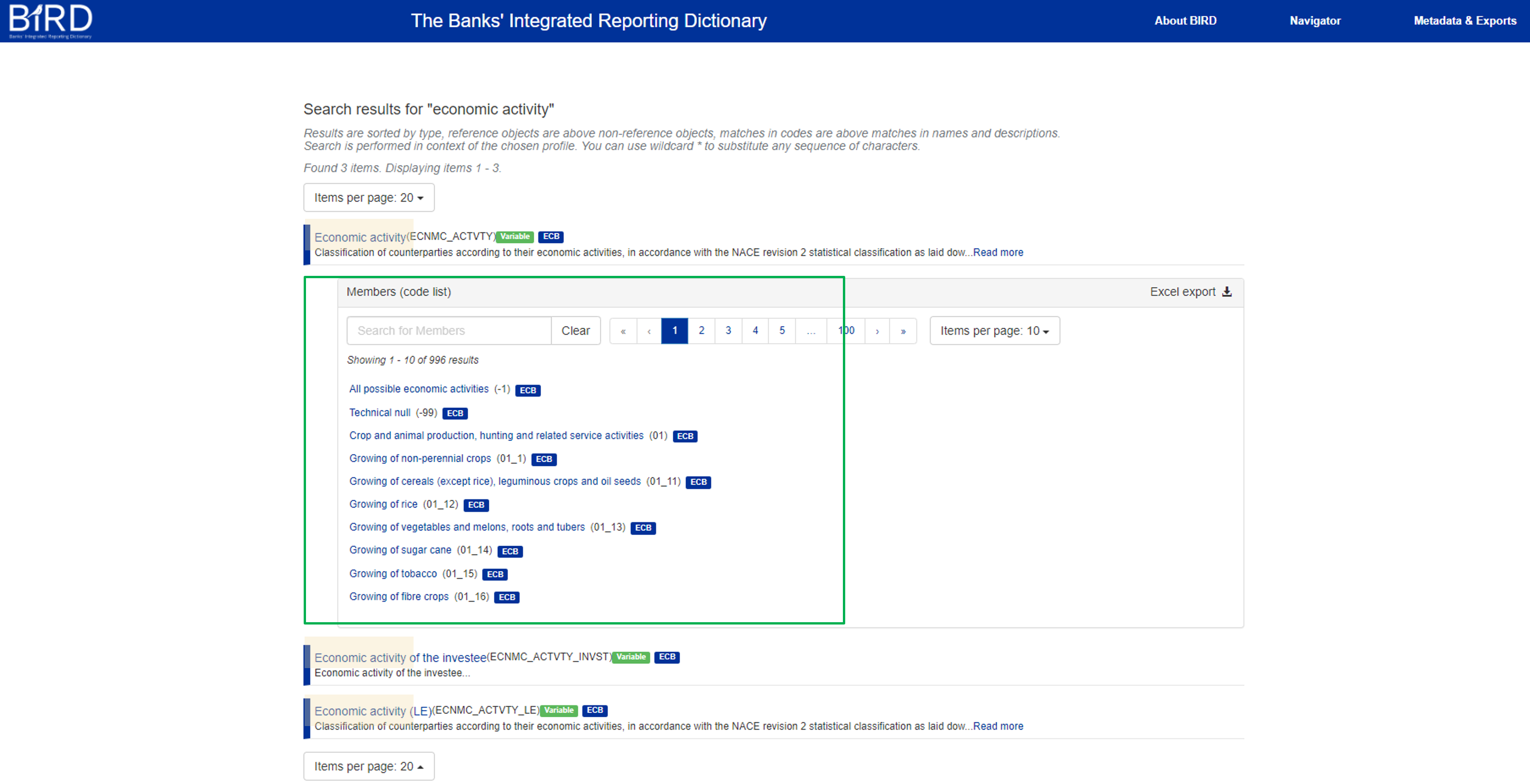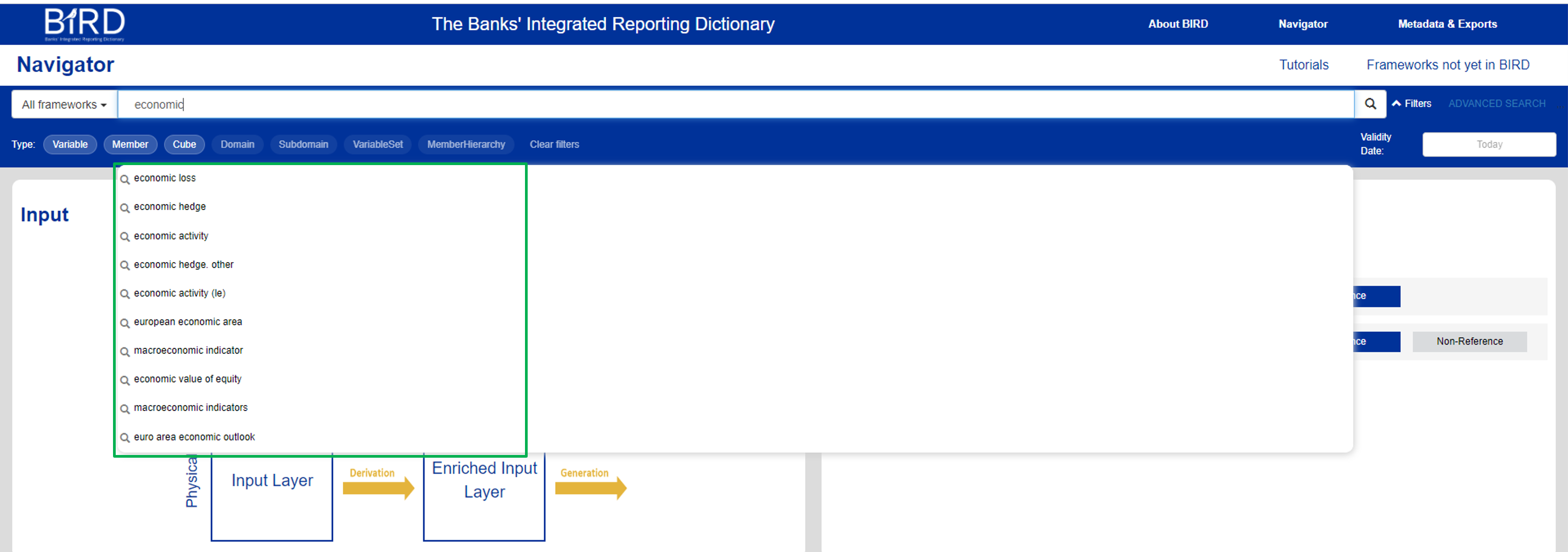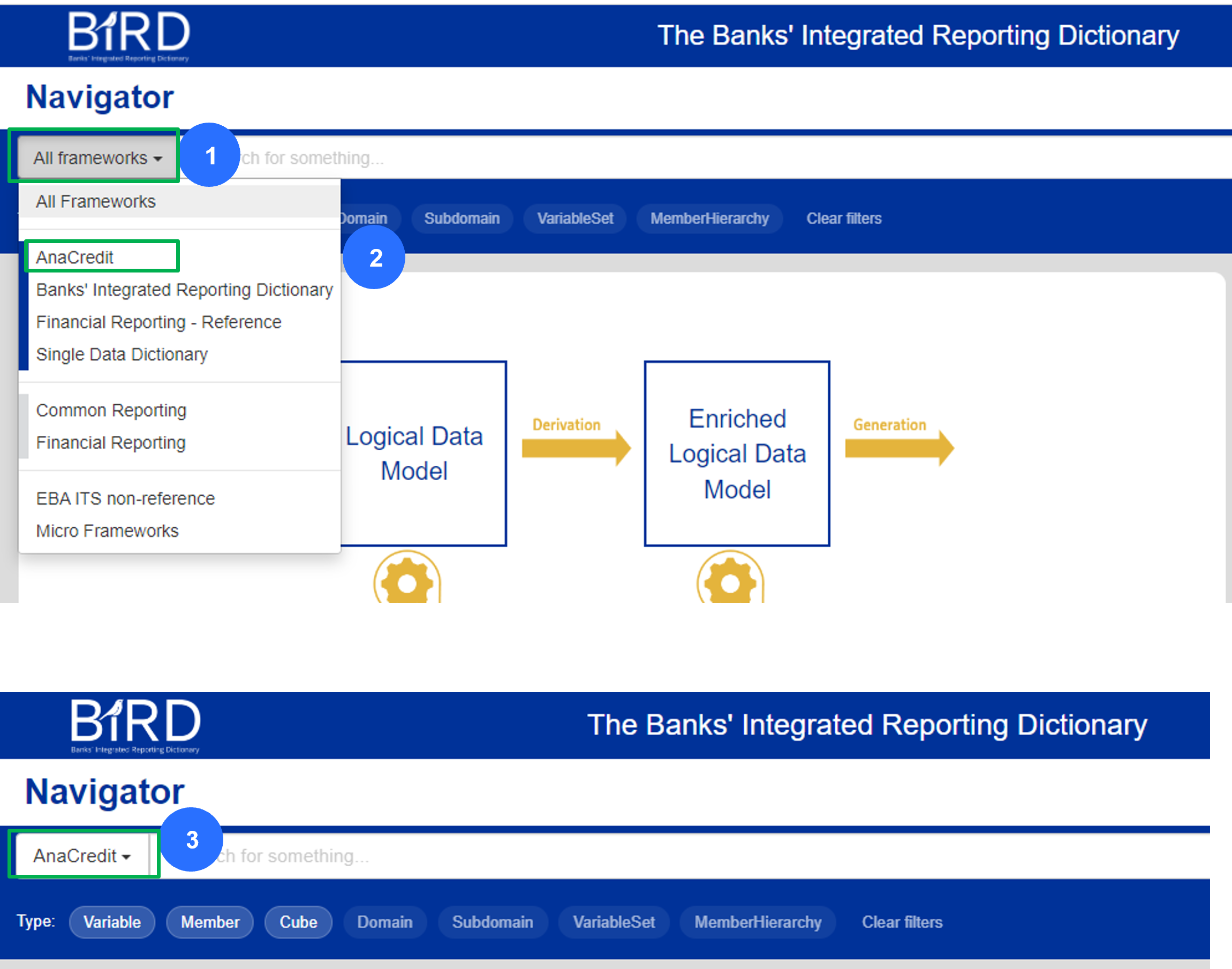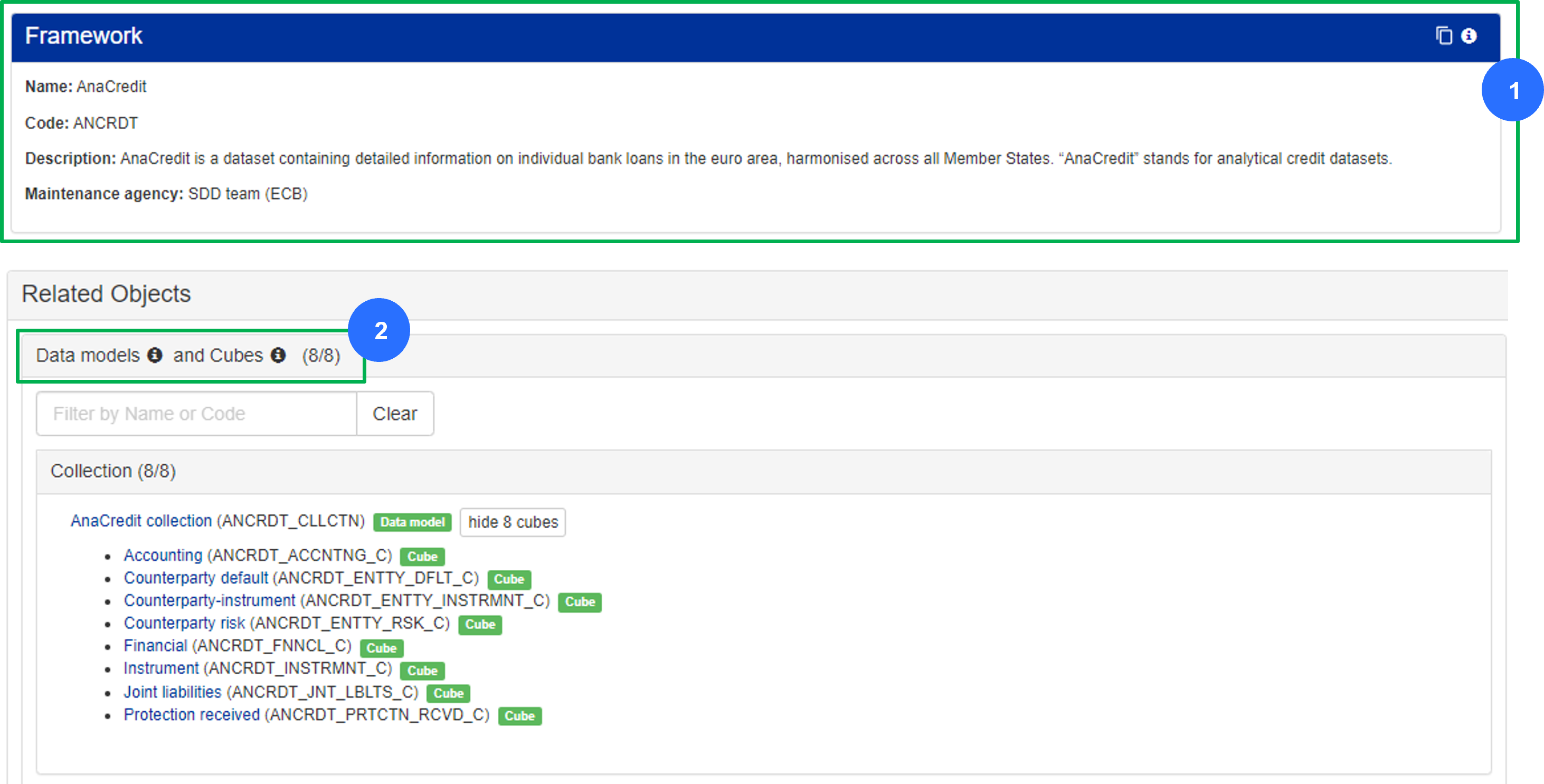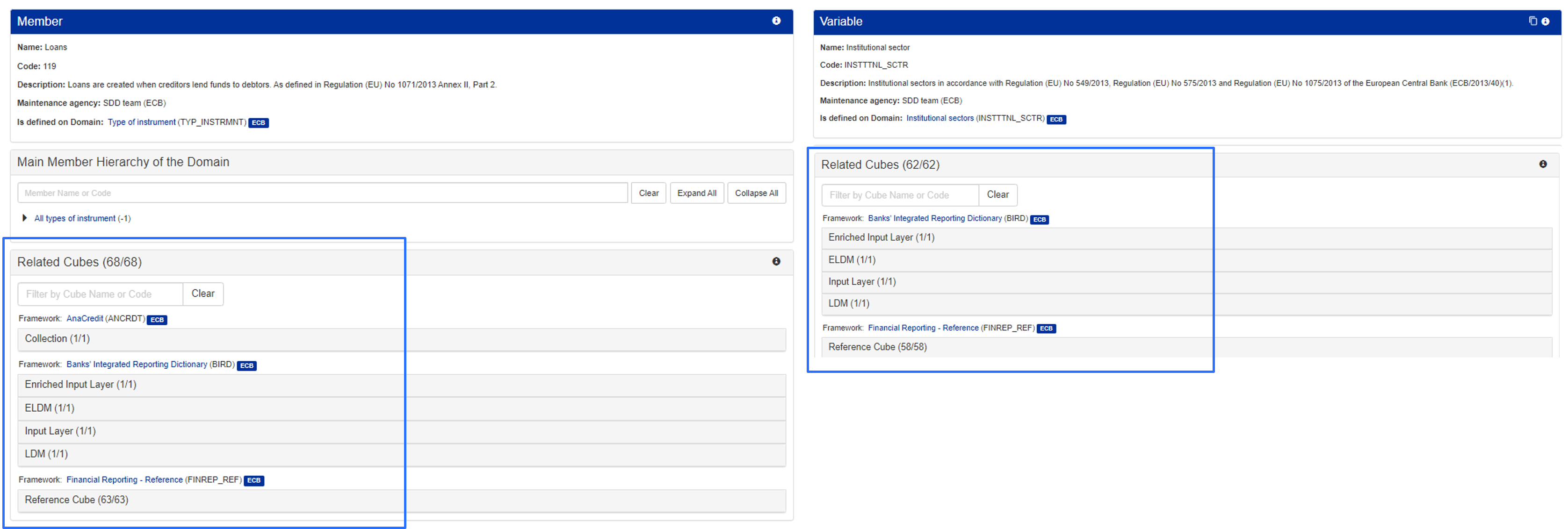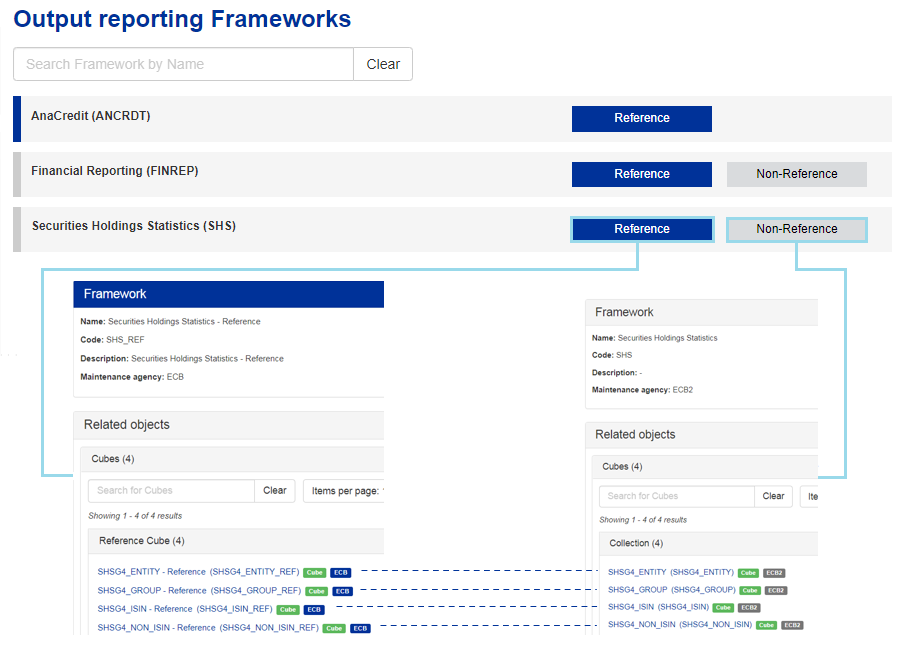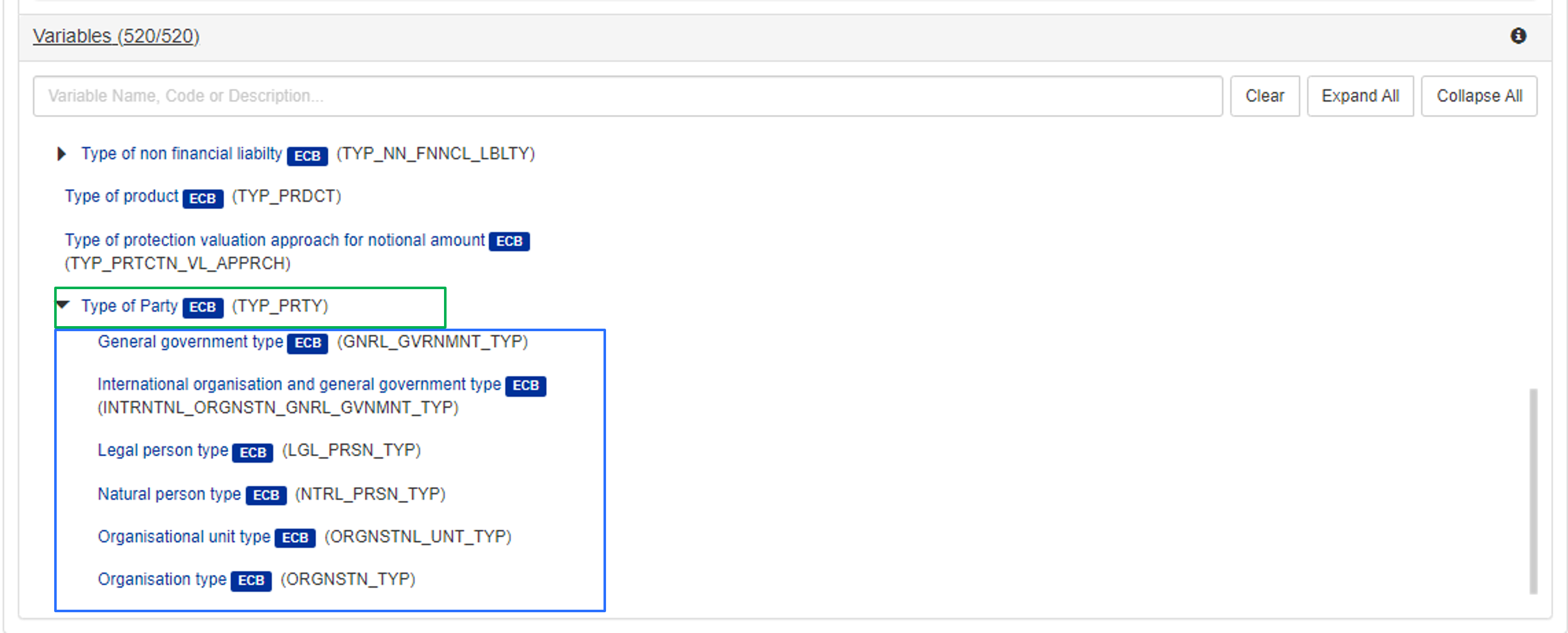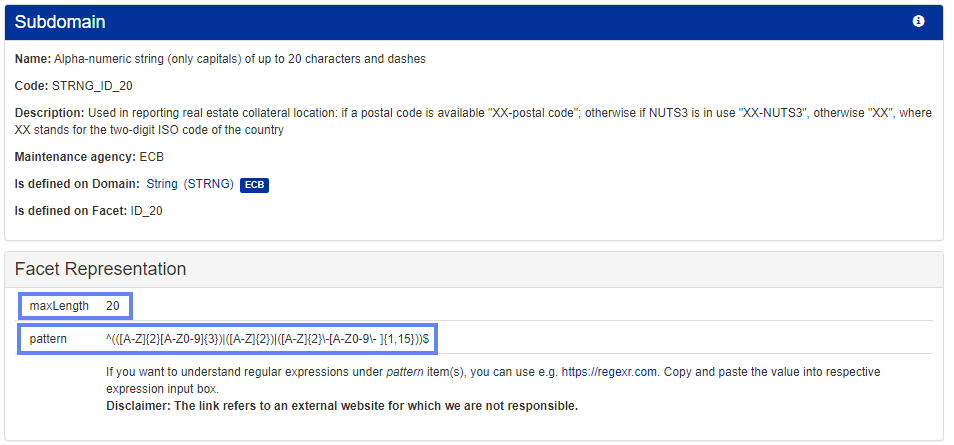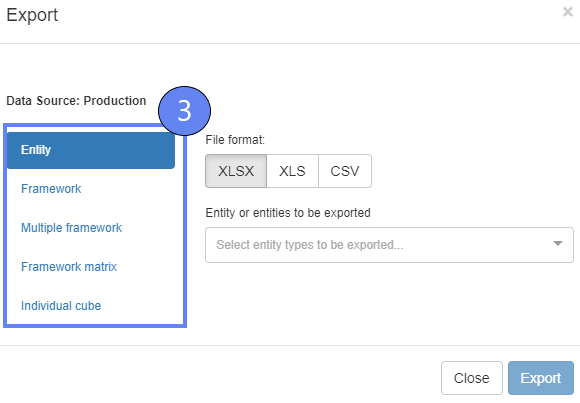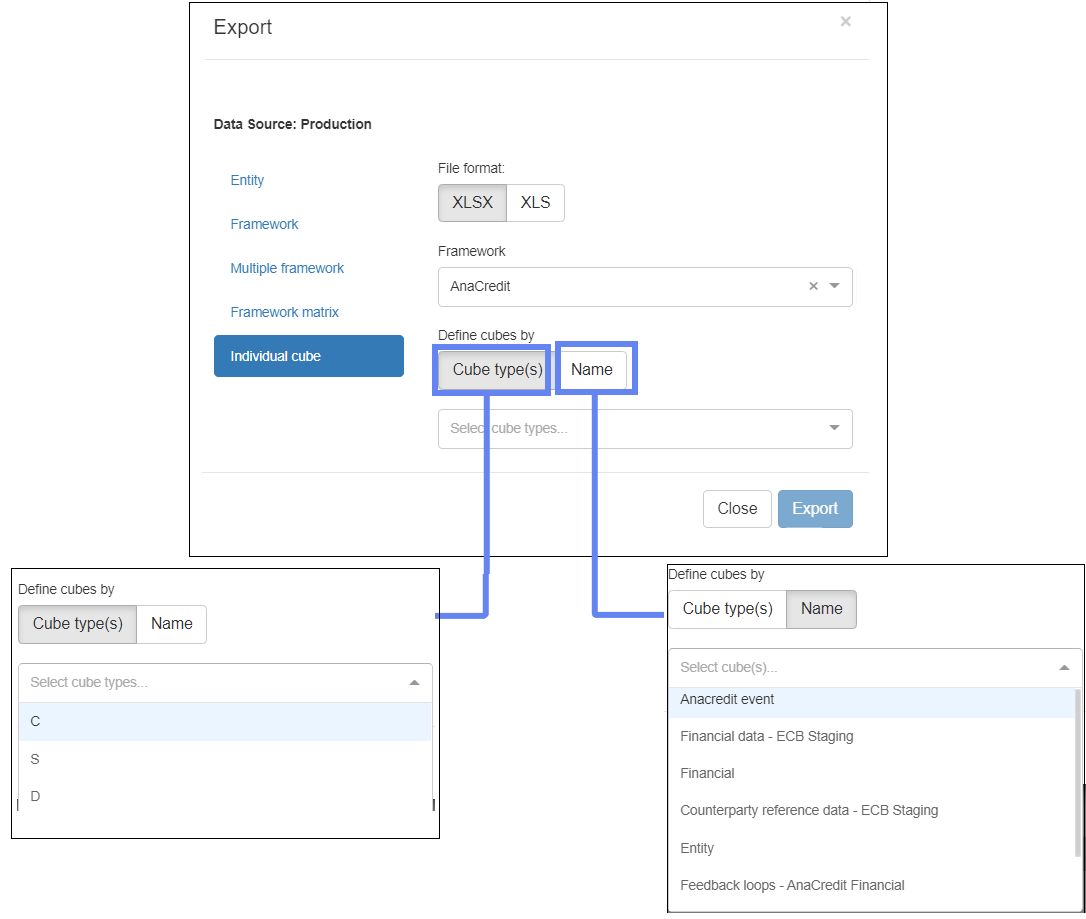Welcome to the BIRD navigator user guide!
The objective of this document is to provide the user of the BIRD navigator with an introduction to the application and its main functionalities.
The document clarifies how to navigate the BIRD content via the navigator features of the BIRD website. It provides the definitions of the concepts used, and guides the user in the exploration starting either from the BIRD Input or Output.
Basic knowledge of the BIRD process and components is required for a better understanding of the navigator functionalities. Please refer to the related section of
About BIRD to discover more about it.
The BIRD navigator allows to navigate through the BIRD concepts and content.
It's a user-friendly representation and interactive navigation of the BIRD content (metadata), supporting the BIRD goals.
In BIRD we often refer to some objects:
- Cube: is the representation of a certain entity type or table. Cubes are typically implemented as tables in a database.
- Variable: is a generic and reusable concept that normally represents attributes in an entity type or columns in a table. They can have different roles: Dimension, Attributes or Observations. Please refer to the Browsing BIRD Input components section for more details about the roles.
- Domain: is a generic restriction establishing the set of values which can be assigned to a Variable. It can be enumerated if the allowed values are countable. In the context of a specific Cube, the set of values can be limited to a more restricted set of values/constraints (Subdomain).
- Member: is a single allowed value of an enumerated domain.
Data from different reporting Frameworks can be expressed using different codification systems (i.e. dictionaries/semantics). They can use different codes to describe the same semantic meaning (i.e. Variables or Members).
E.g. the Member
Central Bank is described using the following codes:
- S121 in AnaCredit
- 1100 in BSI
- S_121 in SHS
- x10 in the Data Point Model (DPM)
Reference and non-reference
In BIRD, we distinguish between reference and non-reference concepts:
- Reference concepts: they are described with a unique codification system (the BIRD) and the
Maintenance Agency is ECB. One of the aims of BIRD is to define a unique set of codes to describe concepts.
The codes must follow a defined set of principles:
- For each word, vowels are dropped, unless they are the first letter of the word
- Words are separated by underscores
- The codes are in uppercase
- etc
- Non-reference concepts: they are described with original codes (original codification system) and the Maintenance
Agency is not ECB (e.g. EBA for FINREP).
E.g. : in BIRD there are two frameworks related to SHS:
reference and
non-reference.
For both the types of frameworks, the tables contain the same informative content and the same granularity.
Additional terminology used in BIRD based on SMCube methodology (metamodel) is described in the table below:
| Maintenance
Agency |
Maintenance Agency is the agency responsible for the maintenance of associated dictionary objects. |
| Framework |
Framework is the regulation or mandate for which the datasets are collected
(e.g. AnaCredit). It contains cubes describing the structure of
the different datasets which belong to the regulation. |
| Subdomain |
Subdomain is the set of allowed values for a variable in the context of a Cube. |
| Facet |
The Facet is the set of constraints for non-enumerated Domains/Subdomains (e.g. max length: 50 characters). |
| Variable Set |
A Variable set is a restriction where the allowed values are Variables (e.g. the metric of the EBA ITS templates). |
| Cube Relationship |
A Cube Relationship is a relationship between Cubes in an Entity Relationship Model (ERM): can represent associations (e.g. an instrument can be protected by many protections) or a generalisation (e.g. a legal entity is a type of party). |
| Cube Link |
A Cube link is a link between Cubes, normally across different models or Frameworks. Is also used to represent the forward engineering between logical and physical models. |
| Combination |
Combination is an object that represents a data point, following conditions to be applicable at the same time on multiple Variables. |
The BIRD provides also a simplified sets of terms for those users who don’t need to exploit all the features of the SMCube methodology. These terms are more commonly used in data management and can be seen as a simplified view on the BIRD metadata model. They are referenced in the BIRD navigator, in some exports and in the BIRD API simplified end-points.
| Entity |
Entity is the representation of an entity type or table of a certain data model (logical or physical). Can also be the underlying structure of an EBA ITS template. It corresponds to a Cube in the SMCube methodology. |
| Attribute |
An attribute is an entity component. In physical tables it normally represents a column of the table. In the SMCube methodology it corresponds to a Cube Structure Item in the context of a Cube and a Variable in a more generic context. |
| Restriction |
Restriction is the domain of allowed values or constraints. In the SMCube methodology it corresponds to a Subdomain in the context of a Cube and a Domain in a more generic context. |
| Allowed Value |
An allowed value is a value for an enumerated restriction. In the SMCube methodology, it corresponds to a Variable when the related Cube Structure Item is related to a Variable Set and to a Member in all other cases. |
| Constraint |
A constraint is a specific property of a non-enumerated restriction (e.g. max length: 50 characters). In the SMCube it corresponds to a Facet enumeration. |
The main page of the BIRD Navigator depicts the BIRD process.
It is possible to access input or output reporting Frameworks' information by clicking on one of the BIRD process component icons.
BIRD Input components can be accessed by clicking on one of the related icon.
For example, by clicking on "Input Layer" we access the related data model, which organises and visualises the related tables and the relatonships among them.
A
Data Model (ERM) is composed of entity types (represented by Cubes, the boxes of the graph) and relationship types (i.e., lines between the boxes of the graph).
On the right side, click and select the entity type to be visualized in the model.
The data models are automatically visualized in an organized way. Nonetheless, the user can move and re-organise the layout of the model.
Additionally, there is the possibility to see the model on fullscreen by clicking on the "fullscreen" button.
By double-clicking on one entity type of the data model or by clicking on the entity type of interest in the hierarchy on the right side, the user is redirected to the correspondent Cube page.
The legend provides information on the type of relationship between entities. The relationships currently implemented are:
- Variable Cardinality: e.g., A Party can have one or many immidiate parent(s)
- Variable Mandatoriness: e.g., An immediate parent must be related to a Party
By clicking on a box, more information about the Cube is shown.
By clicking on a line, the description of the relationship is shown.
You may find the list of attributes and related restrictions in the Cube representation section.
They are categorised according to their Role.
Dimensions represent identifiers of the cube, which allow the identification of a unique record in the cube (e.g., Party identifier, Party Reference Date and Party Reporting agent Identifier).
Observation values are items that provide information on the full set of dimensions (e.g., measures such as Annual turnover, Balance sheet total).
Complementary attributes provide additional information on a single dimension or observation value. Attributes are dependent variables, but they depend on a single element
(that can be dimension or variable), while the observation values depend on the combination of all values for the dimension (e.g., currency referring to a specific variable)
BIRD Output components can be accessed in the "Output reporting Frameworks" section on the right-hand side of the homepage.
In the home page, the Frameworks are organised in “Reference” and “Non-Reference”.
- Reference version uses the common BIRD reference dictionary. This version is more easily linkable with the BIRD input.
- Non-Reference version refers to the original codification system.
Click on one Framework to access the related information.
Prudential Frameworks
Prudential frameworks, such as FINREP, can be browsed by visualizing
single annotated templates which are represented by Cubes in BIRD.
The only difference between reference and non-reference versions of the Frameworks will be on the codification used to represent Variables and Members. The layout of the templates represented will be mostly the same.
In General, reference Frameworks are interesting in order to be integrated with other reference Frameworks.
Non-reference Frameworks are interesting for those who would like to browse the information of the data points as originally codified (in the taxonomy provided by EBA)
In addition, for the prudential frameworks it is possible to visualize in the BIRD Navigator the Data Point Templates by selecting a cube inside the "Cube" section of a specific framework.
Statistical Frameworks
Statistical Frameworks, such as AnaCredit and SHSG can be browsed Cube by Cube if the user knows in advance which is the Cube of interest.
In addition, when available, the user can browse the
Data Models which give an overview of multiple entity types of a Framework (and their relationships) based to certain business needs. In some cases, a data model would be simply represented by a single entity type, and therefore it is omitted.
By double-clicking on one entity type of the data model or by clicking on the entity type of interest in the hierarchy on the right side, the user is redirected to the correspondent Cube page.
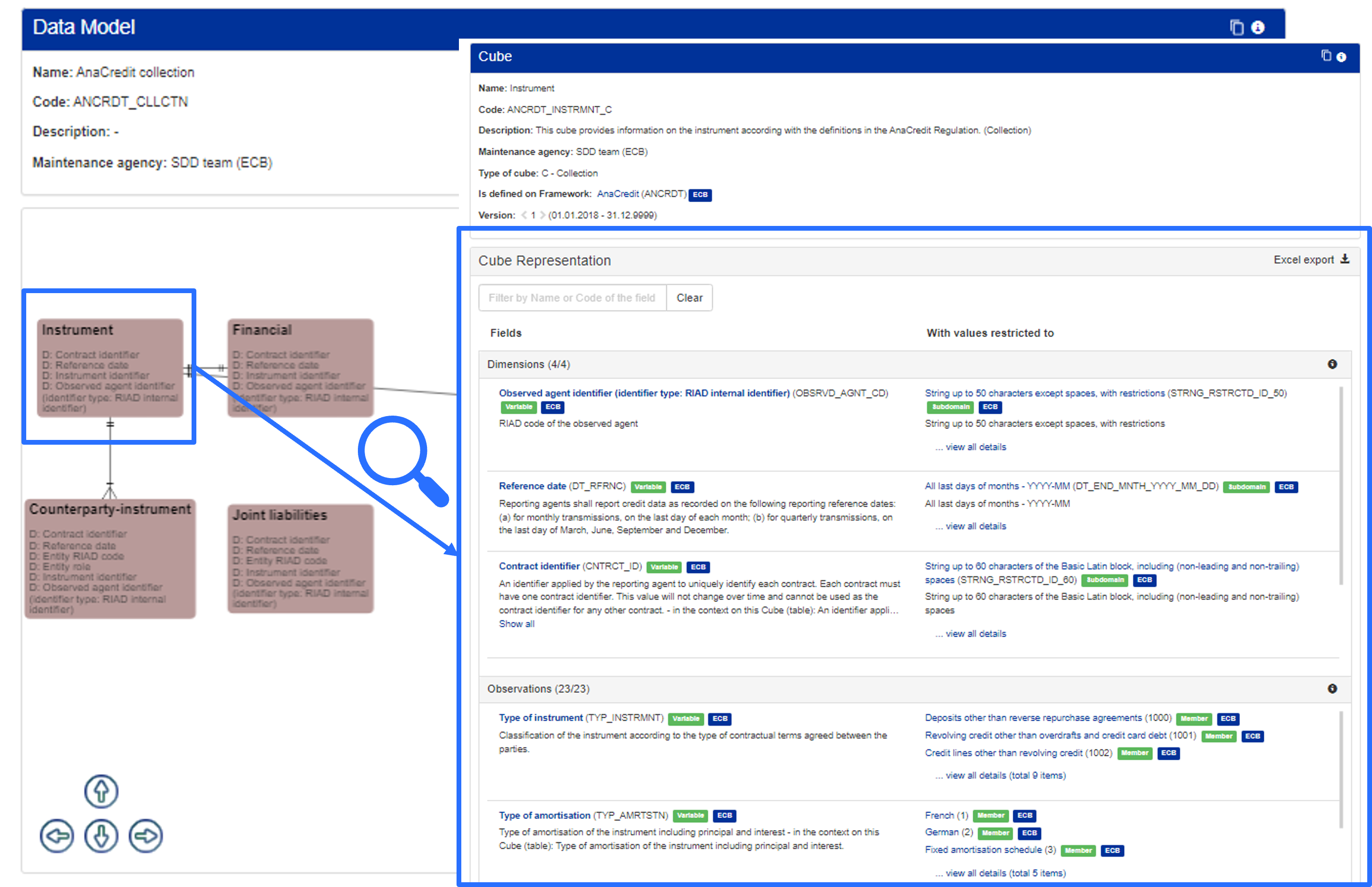
Step 1: Click on Navigator to browse the BIRD content
Step 2: Click on Filters to see the list of objects you can filter your search on
Step 3: Click on the objects you are interested in. By default it will only search for Variables, Cubes, and Members
Step 4: Type something in the search bar (e.g., economic activity) and click on the magnifying glass (or press Enter)
Result:
List of objects (e.g., Cubes and Variables) related to the entry in the search bar (e.g., economic activity). The green label shows the Object Type:
- Framework
- Cube
- Variable
- Subdomain
- Member
- Domain
- Combination
When searching for a Variable, the BIRD navigator automatically showcases the Members that Variable uses.
The BIRD navigator has an auto-complete function that eases the search process. Searching for "economic", for example, will showcase a set of possible options, such as
economic loss ,
economic hedge and
economic activity.
The user can also search for meta-data of a specific Framework.
Step 1: Click on “All frameworks” to choose the Framework
Step 2: Click on the Framework to narrow the search
Step 3: When searching for an information, only those related to the selected framework will be shown (e.g., AnaCredit)
Related information are those elements that further describe a component in BIRD (e.g., Cubes, Variables, Frameworks)
Step 1: Browse the information related to the Framework (e.g., AnaCredit)
Step 2: Search for a certain Data Model or Cube. The results can be grouped by the type of cube (e.g., dissemination, collection, etc...)
Step 3: Filter for a variable of interest (e.g., Accumulated impairment). The result is a list of variables whose name matches the criteria
In the Member and Variable views, it is possible to visualize which Cubes they are used in.
It is also possible to visualise Cubes that are using a more specific or more generic concept.
This type of relationship is a metadata link expressing the fact that a metadata object is used across different Frameworks / data models, it does not necessarily imply that data processes are defined to derive the Variable or generate the related Cube.
In addition, the user can find information on other related meta data, e.g. Member Hierarchies, Variable Sets and Mapping Definitions.
The hierarchy organises Members of a certain Domain in structure allowing to understand the relationships between them (i.e., which is more specific and which is more generic).
There can be multiple hierarchies associate to a certain Domain, representing different breakdowns of a certain Member (e.g. breakdown of Loans depending on different regulations).
Some Domains however, have a
main hierarchy which is the starting point to understand the hierarchical structure of this Domain.
Such hierarchy will also be visibile in the Variable view.
For example, by accessing the Type of Instrument view, we will be able to see its main hierarchical structure (tree structure):
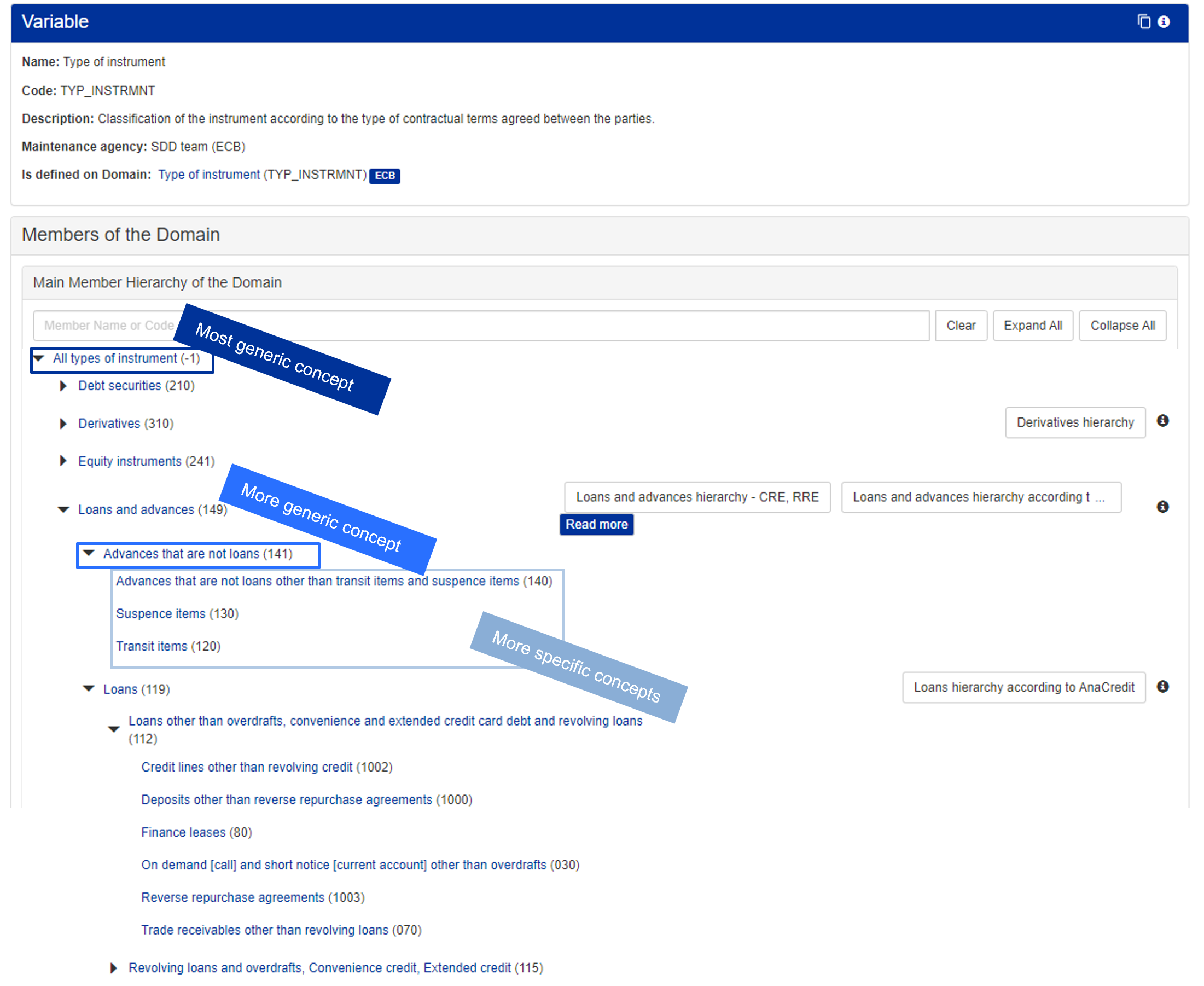
By clicking on each Member the user is redirect to the respective Member view.
What is the difference between a Reference and a Non-reference framework?
| Reference |
Non-Reference |
| Reporting Framework are described with the unique codification system of the BIRD Framework.
|
Reporting Frameworks are described with original codes, the Maintenance Agency is not ECB (e.g. EBA for EBA ITS).
|
| Frameworks are easier to be linked/integrated with other reference Frameworks. |
Frameworks are harder to be integrated with other Frameworks. |
NB: The tables contain the same informative content and the same granularity but they are described with different codes
Mapping is an operation that consists of linking concepts from a non-reference dictionay with the corresponding ones of the common reference dictionary (see
Dealing with different codification systems).
In the mapping process we map Variables and Members of the involved Cube(s)
From the
Cube Variables Mapping section of the Cube view it’s possible to match the Variables of the Non-reference cube with those of the reference Cube (i.e., mapped variables).
Simple mappings consist of 1 Variable mapped to 1 Variable (e.g. Frequency, Unit), some others are 1 to n (e.g. Instrument ESA-2010 class) or even m to n.
Below an example of Mapping Representation for
SHSG - NON ISIN data: Issuer Sector (1:many Mapping)
It is possible to apply similar concept of Member Hierarchies to the Variables; in this case we refer to Variables and Primary Variables.
Primary Variables represent the most generic concepts that refer to a certain Framework. In Micro Frameworks some Variables of
Cubes that are disseminated to final users can derive from a calculation that is necessary to represent a certain perspective.
In that case, the original (source) Variable of the calculation (e.g. from the Collection Cubes) will be considered a “Primary Variable”.
In some other cases the Primary Variables are simply a generalisation of the more specific ones.
In the example, General government type, or Legal person type are more specific views of the more generic Party type.
The Primary Variables section is useful to have a more simplified overview of the Variables of the framework.
Non-enumerated Variables are normally constrained by a set of rules on the values that can be admitted. This set of rules is called Facet.
Some rules are trivial (e.g. The Maximum/Minimum value acceptable) while some others are represented by a pattern: i.e., regular expression which displays a more complex rule to be applied to validate the field.
There are different types of rule that can be shown:
The user can download a user-friendly
individual Cube export from the specific Cube view:
Furthermore, the user can export the SDD content, in various different structures, from the
Metadata & Exports Section:
Step 1: Click on Metadata & Exports.
Step 2: Click on Export.
Step 3: Select the type of export you want to perform
- Entity export allows you to export one or several BIRD entities (e.g Cubes, Variables, Subdomain), following the BIRD technical format (SMCube)
- (Multiple) Framework export allows you to export all the entities related to (multiple) a framework
- Framework Matrix and Individual Cube exports allow you to export entities in a business oriented way
The export of Individual cubes can be by
Cube type(s) (Collection, Staging and Dissemination) or
Cube name.
The export is in Excel format and contains:
- One sheet per cube exported, with the list of the involved variables and the information on subdomain, role, description.
There is one cube sheet in case of Cube name export, more than one sheet in case of Cube type(s) export
- A number of sheets related to the subdomains involved in the export. They contain the members or the pattern of the subdomain
